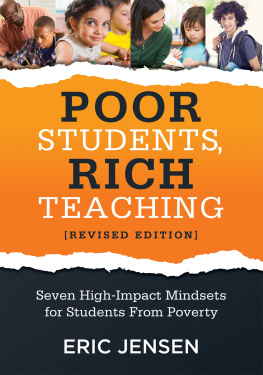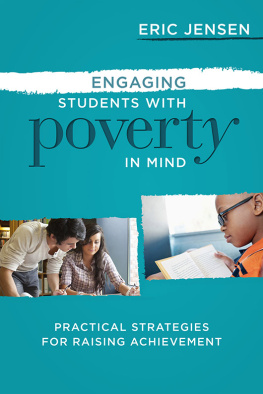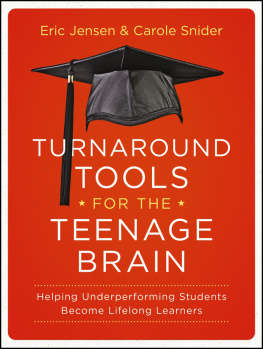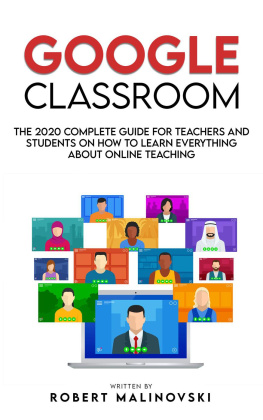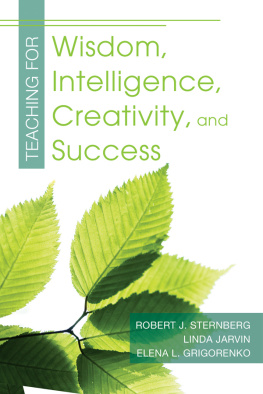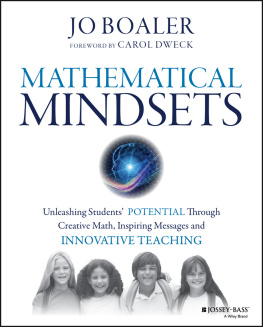POOR
STUDENTS,
RICH
TEACHING
MINDSETS FOR
CHANGE
ERIC JENSEN

Copyright 2016 by Solution Tree Press
Materials appearing here are copyrighted. With one exception, all rights are reserved. Readers may reproduce only those pages marked Reproducible. Otherwise, no part of this book may be reproduced or transmitted in any form or by any means (electronic, photocopying, recording, or otherwise) without prior written permission of the publisher.
555 North Morton Street
Bloomington, IN 47404
800.733.6786 (toll free) / 812.336.7700
FAX: 812.336.7790
email:
solution-tree.com
Visit go.solution-tree.com/instruction to download the free reproducibles in this book.
Printed in the United States of America
20 19 18 17 16 1 2 3 4 5

Library of Congress Cataloging-in-Publication Data
Names: Jensen, Eric, 1950 author.
Title: Poor students, rich teaching : mindsets for change / Eric Jensen.
Description: Bloomington, IN : Solution Tree Press, [2016] | Includes bibliographical references and index.
Identifiers: LCCN 2015042879 | ISBN 9781936764518 (perfect bound)
Subjects: LCSH: Children with social disabilities--Education--United States. | Poor children--Education--United States. | Educational equalization--United States.
Classification: LCC LC4091 .J457 2016 | DDC 379.2/60973--dc23 LC record available at http://lccn.loc.gov/2015042879
Solution Tree
Jeffrey C. Jones, CEO
Edmund M. Ackerman, President
Solution Tree Press
President: Douglas M. Rife
Senior Acquisitions Editor: Amy Rubenstein
Editorial Director: Lesley Bolton
Managing Production Editor: Caroline Weiss
Copy Chief: Sarah Payne-Mills
Proofreader: Ashante K. Thomas
Text and Cover Designer: Abigail Bowen
Acknowledgments
I am indebted to the groundbreaking work of many researchers, the vision and patience of Douglas Rife, and the saintly support of my wife, Diane. I also thank the many high-performing teachers whose work has enriched this project, including LeAnn Nickelsen, Whitney Henderson, Jamie Irish, Leslie Ross, Katie Lyons, Victor Shatalov, and Josalyn Tresvant.
Solution Tree Press would like to thank the following reviewers:
Stacie Emert
Principal
Wheeler Elementary School
Tucson, Arizona
Ellen L. Hall
Principal
Claiborne Fundamental Magnet School
Shreveport, Louisiana
Jacque Wyant
Principal
Sioux City West High School
Sioux City, Iowa
Visit go.solution-tree.com/instruction to download
the free reproducibles in this book.
Table of Contents
About the Author

Eric Jensen, PhD, is a former teacher from San Diego, California. Since the early 1990s, he has synthesized brain research and developed practical applications for educators. Jensen is a member of the invitation-only Society for Neuroscience and the Presidents Club at Salk Institute of Biological Studies. He cofounded SuperCamp, the first and largest brain-compatible academic enrichment program, held in sixteen countries with over sixty-five thousand graduates.
Jensen has authored over twenty-eight books, including Teaching With Poverty in Mind, Tools for Engagement, Engaging Students With Poverty in Mind, Turnaround Tools for the Teenage Brain, Bringing the Common Core to Life in K8 Classrooms, and Different Brains, Different Learners.
To learn more about Eric Jensens teacher workshops and leadership events, visit Jensen Learning ( www.jensenlearning.com ).
Preface
This brief (and true) story is about a boy whose life took a grim turn for the worse at age two when his mother walked out. After four bizarre years of neglectful caregivers, his dad remarried (for the second of four times). His new stepmother was violent, alcoholic, and abusive. She made the home life a living nightmare for her stepchildren. This boy nevereverwent into the kitchen when she was there, because thats where the knives were. This kids older sister moved out and lived next door with the neighbors for seven years, and his other sister moved into the garage with no bathroom for eight years.
The boys father felt trapped in a bad marriage. He worked during the day, went to night school, and had busy weekends with the National Guard. The boy was often locked out of his own house, and he snacked from a bag of dry dog food in the garage in between meals. From second through tenth grades, his violent stepmother terrorized and abused him. To escape the hellish home, his dad sent him to live with his aunt and uncle (a new school), with his grandmother (another new school), or with his sister to live independently (another new school). This boy understood chaos on a daily basis.
After each move away, his stepmother would promise to be good, and theyd move back home. The cycle of violence repeated itself again and again. Moving around was the norm, not the exception; this kid went to three elementary schools, four middle schools, and two high schools. At one count, he had 153 teachers.
The K12 school experience was disconnected, and the home experience was terror. This kid was never at any school long enough to develop many friendships. He was often truant and sent to the office for discipline issues. In class, he usually sat in the back, stressed and wondering, What is it going to be like when I get home? Will I get hurt again? For him, home was a source of chronic stress. Yet, all of this felt absurdly typical. Among his three closest male friends, two also had abusive parents.
Why am I telling you this story? This story is about me, and it is the real story of my early life.
I have been criticized because I write about poverty and I am white and middle class. Guess what? Bad things can happen to people of any religion, socioeconomic class, or ethnicity. I have been told that since I didnt grow up in poverty, maybe I dont know adversity. It is likely you have no idea how I grew up. I have had a loaded, cocked gun held to my head, and I heard, Do what I tell you, or I will shoot! I was arrested twice, and I barely graduated from high school. Honestly, I do know a little bit about getting knocked down and, more important, about getting back up.
Thats what this book is about: choice. Everyone gets knocked down; for some, it is more often and more traumatic than others. But you still have a choiceare you going to get up or not? This book is about how you can give students a helping hand to get up until they can learn to do it for themselves.
Youll hear me say this several times in this book: Lifes not fair, but you always have a choice. You have choice in the classes you take at a university, job you interview for, the job you accept, the attitude you bring to work, what you do at work, the people you call friends, the food you eat, the person you marry, the children you have (or dont), how you raise your children, and how you spend your time. Yes, you do have a choice.


